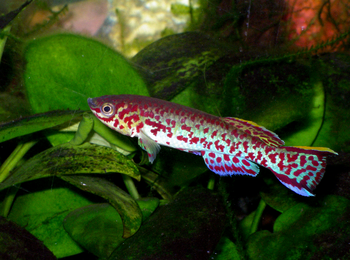 |
| Fundulopanchay - Photo: Wikimedia |
Actually, the word killifish does not indicate a killer fish but it is taken from a Dutch word which means a ditch. Likewise, Golden pheasants or Blue Gularis Killifish love to stay in shallow waters or in marshes.
They are a very good addition to your aquarium because of their different and attractive colors and swift actions. The males are usually found in red and blue colors and they have yellow fins. The females are usually in brown or gray colors and they have a few spots on their body.
They are not demanding by nature and they can adjust to living under different conditions of water. The only requirement which should be fulfilled for them is to install many plants in the aquarium. They are happy to live in water containing some salt.
Live food is their favorite diet. If you regularly supply them brine shrimps or white worms, they will be very happy to live. Occasionally you can feed them with flaked food and frozen food items.
They are large in size and they can grow up to 6 inches. So they should be kept in a bigger aquarium or a pond. If you can provide a 10-gallon tank for a pair, they are happy to stay in.
When they are six months old, they are ready to spawn. Younger Golden pheasants can also spawn but they will be producing a lot of infertile eggs. If you want to get a higher percentage of fertile eggs, you should take a pair of at least 10 months old.
You should keep the male and the female separately before actual spawning. You can do this by putting a partition in the aquarium. During this time you should provide good food to both of them and you should also keep the temperature of the water around 75 F.
They usually like to lay eggs on mops for on a substrate of peat. You can use a plastic container for the peat moss and put it at one corner of the aquarium. Otherwise, you can use two mops alternatively and collect the eggs from them every day.
Usually, it takes about 10 to l2 weeks for hatching the eggs. However, it all depends on the conditions you have created in the aquarium. You should keep these eggs in smaller containers with about 5 inches of well-treated water. The young ones will start eating immediately and you should feed them with baby brine shrimp.
The young ones will grow very fast and you should look after them very well by providing them good food and clean water. You should change the water frequently and use a powerful water filter to keep it clean. Once they are six weeks old, you can treat them as adults and you may shift them to the main aquarium.
You should always keep small ones of different sizes in separate compartments because the larger fry may attack and hurt the smaller ones.
If you want to develop a colorful aquarium with different varieties of fish, you should select Golden pheasants as they will not demand much from you and their presence will please all members of your family.
Chintamani Abhyankar is a goldfish enthusiast and has been raising and breeding goldfish for many years. He is an expert on their care and an advocate for raising healthy goldfish the natural way. Article Source: EzineArticles |

